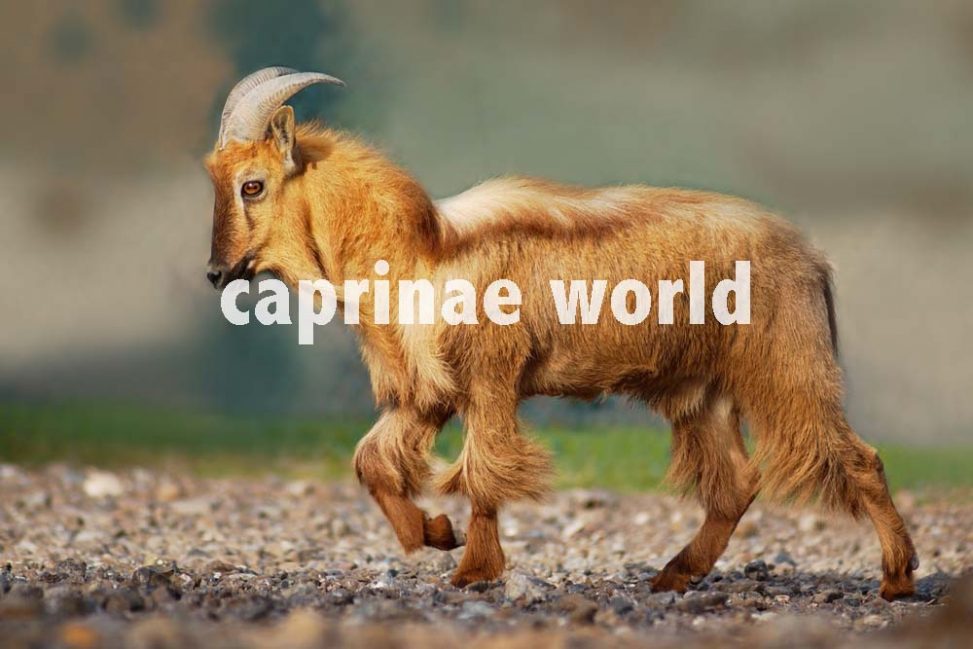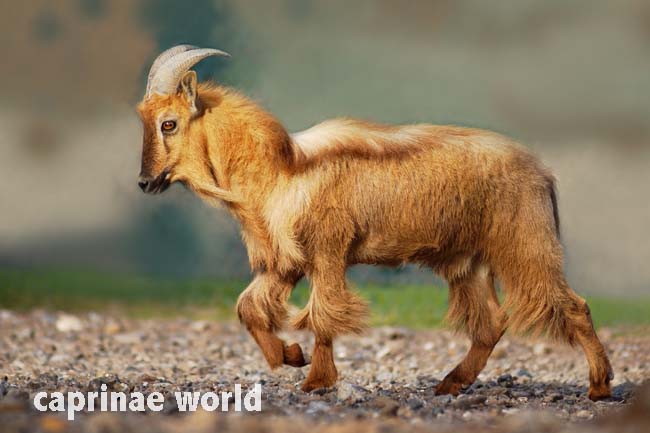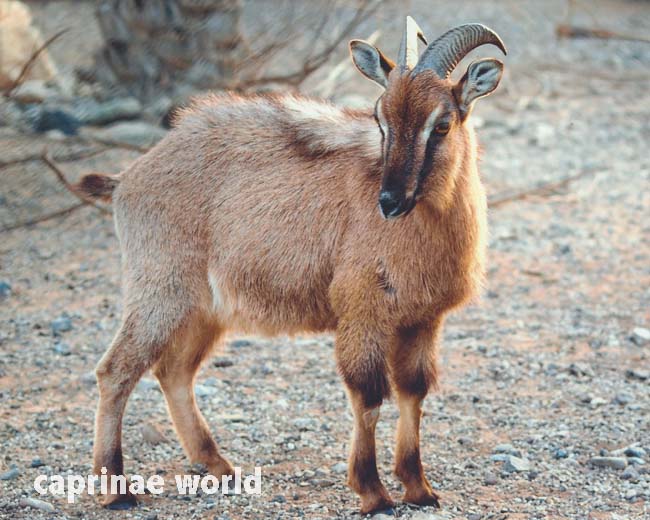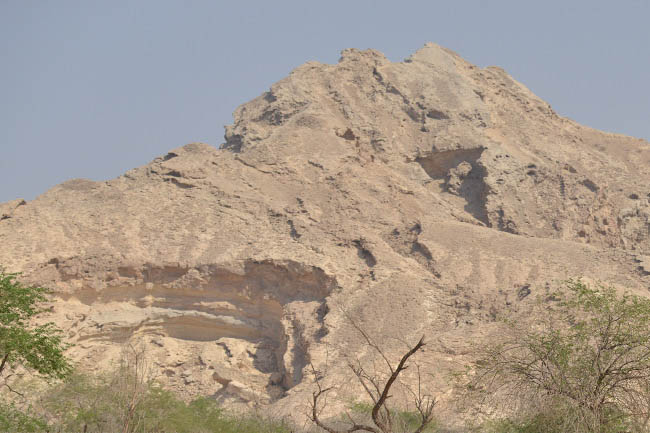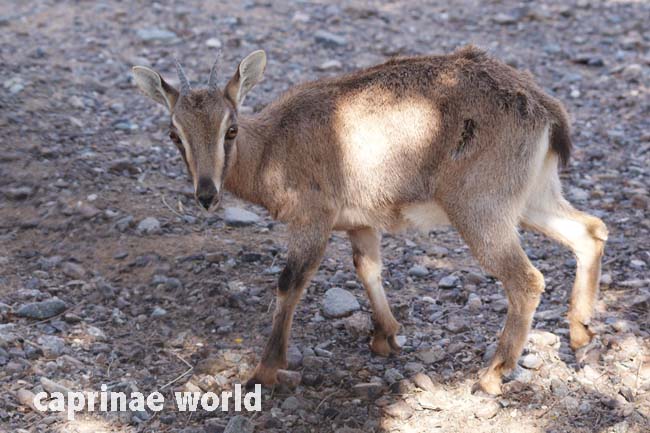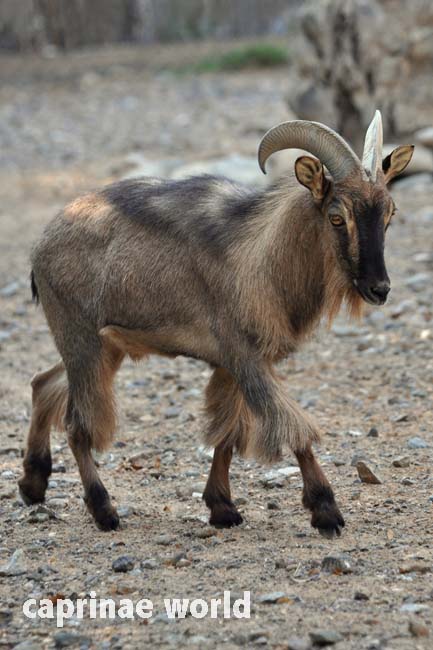Of the three tahrs this species is the smallest. It is more closely related to the Aoudad.
Names
Arabian: al wa’al al arabi [1]
English: Arabian Tahr [1, 3]
French: Aoudad d‘ Oman [3], Tahr d’Arabie [1]
German: Arabischer Tahr [1]
Spanish: Tahr de Omān [3], Tahr de Arabia [1]
Taxonomy
Hemitragus jayakari Thomas, 1894, Oman
No subspecies are recognized. [1] The first description is based on skulls collected by Surgeon Major Atmaran S. G. Jayakar in Jebel Taw in the northeastern extremity of the Jebel Akhdar massif. [3]
This species is more closely related to the Aoudad (Amotragus lervia) than to the other two tahr species, Himalaya Tahr (Hemitragus jemlahicus) and Nilgiri Tahr (Nilgiritragus hylorcrius). Formerly classified in the genus Hemitragus, now classified in a separate genus, Arabitragus. Monotypic. [3, 4]
Similar species
There is some superficial resemblance with the two other Tahr species, but distribution excludes confusion (Arabian Tahr: Arabian Peninsula; Nilgiri Tahr: South India; Himalayan Tahr: Himalaya).
Distribution
Countries occurrence: Mountain Ranges of East Oman, barely extending into the United Arab Emirates [4]
There are small scattered populations throughout the 600 km crescent in northern Oman, from the limestone massifs of the Musandam, through the Hajar Mountains as far as Jebel Qahwan due south of Sur. Sightings in the Musandam, the United Arab Emirates and the northern Batinah Region of Oman are sporadic and rare, mainly due to depleted numbers and the inaccessibility of the tahr’s preferred habitat.
Further south the tahr is reported to be thriving in areas of preferred habitat where it has effective ranger protection and competition from domestic goats is limited. The most important populations occur near Nakhl, the Wadi As Sareen Nature Reserve and Jebel Qahwan in the Ja’alan. In addition to the well-vegetated limestone escarpments, tahrs range through the lower altitude ophiolite mountains which form nearly 60 percent of its former habitat. Although the vegetation here is sparser and less diverse, there are more open pools and perennial springs due the lower permeability of the rock.
Insall (1999) noted that, of the historic range of 19.413 km², recent occurrence was noted in hectads (10 km x 10 km square) totalling 8.863 km². In a further 6.924 km² of hectads the species‘ occurrence was unclear, and it was reported as extinct in the remaining 3.653 km² of its historic distribution.
General discription
length / head-body: 93-95 cm [3]; 95 cm – the smallest of the three tahr species [1, 3]
shoulder height: 61-64 cm [3]; 62 cm [1]
weight: males 38-45 kg, females 17-20 kg [1, 3] – about half the mass of the Himalayan Tahr, females are about half the mass of males [1]
hindfoot: 20 cm [3]
tail: 8,4-10 cm [3]
karyotype: 2n = 58 [3, 4]
Coloration / pelage
in general: brownish to pale sandy; whitish-brown with coarse shaggy hair [1]
male winter coat: shaggy, with ruffs on the legs (only during winter?) and tufts at the angle of the jaws. Pelage is tawny-brown [3]
female pelage: paler [3]
dorsal stripe: dark; from the nape to near the base of the tail; mid-dorsal tuft of hairs, which is better developed in males than in females.
tail: black with terminal tuft [3]
underside: buffy whitish [4], whitish [3], light [1]
legs: dark markings on front of lower legs [3]
head: two distinct black facial markings, one covering the dorsal aspect of the muzzle and another extending from the lower margin of the eyes toward the angle of the mouth. There is a pale brown narrow stripe between the black facial markings [3, 4]. This stripe can be whitish infront of the eyes. As males get older, the facial striping is lost and face becomes blacker. [1]
beard: only in males (elongated cheek)
other extended hair: (see: sexual dimorphism)
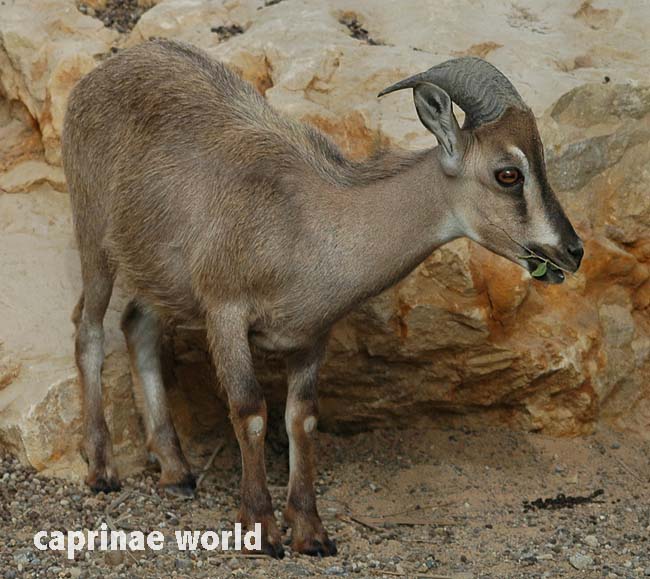
Presumably young Arabian Tahr male. Note the white markings between eye and nasal bridge. Photo: Breeding Centre for Endangered Arabian Wildlife
Horns
The horns are close to the base, slender, and laterally compressed. They diverge at about 45° and curve backward, narrowing rapidly to the tips, with a relatively smooth anterior keel. [3] Relative to body size, the horns of the male Arabian Tahr appear longer than those of the Himalaya Tahr, albeit more slender, less wrinkled on the sides and less knotted on the frontal keel. In absolute measurements the Arabian Tahr’s horns are, however, considerably shorter [1], and much shorter than in Aoudad. [4]
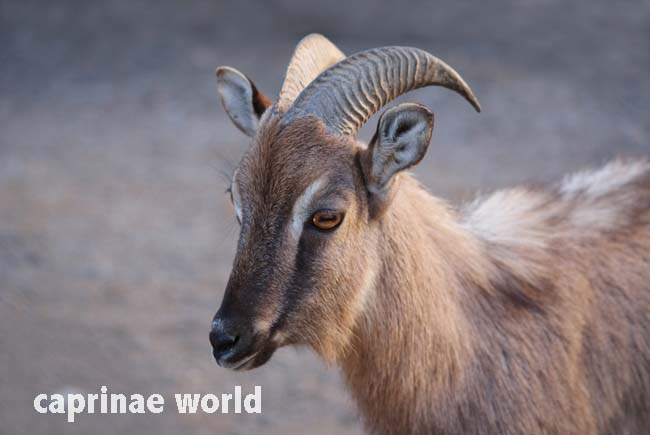
Gentle wrinkles on the surface and an anterior keel are typical for Arabian Tahr horns. Photo: Wolfgang Dreier/BCEAW
The longest recorded male horn measured 32 cm. [3] Only three trophies have been entered in Rowland Ward over time. Average horn length is probably between 28 and 30,5 cm and base circumference between 12 and 15,5 cm. [1]
Female horns are shorter and [3] and thinner [1] than those of males.
Different growth rates: Male and female horns grow at different rates, with male horns increasing more rapidly in length up to the third year. In the female, however, the rate of growth declines only later, between the fifth and seventh year, although never approaching the maximum growth rate of the male, being somewhat less than half. Female horns break more easily, owing to the lesser strength of the horn boss (Munton 1985). [1]
Sexual dimorphism
Males are larger [3] and possess extended hair that grows longer with age [5], which extends on jaws [1], down the nape, flanks [4], back [5] and upper legs.
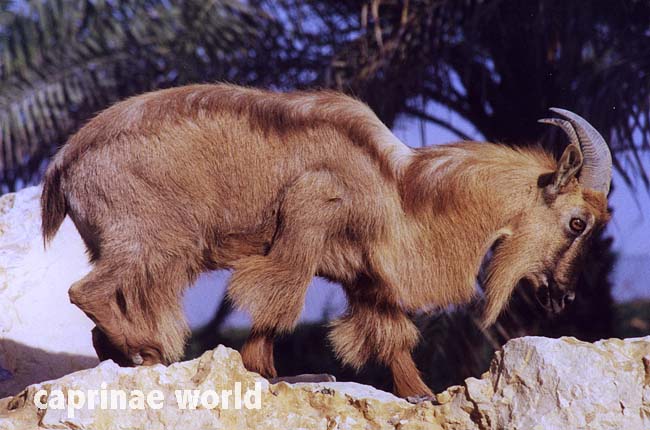
Very impressive Arabian Tahr male with extra long beard. Photo: Breeding Centre for Endangered Arabian Wildlife
Only males have a beard [3] in the sense that they have elongated hair on their cheeks, but the don’t have a goatee. Older males also get a black muzzle and darker eye stripes [5] and they have bigger horns. The black markings on males are visible from a considerable distance (Munton 1985). [1]
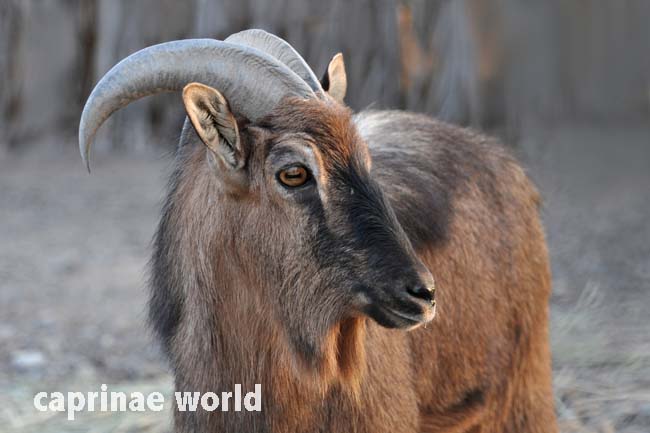
As males become older, the black facial stripes merge to form a uniform dark face. Photo: Breeding Centre for Endangered Arabian Wildlife
Females are much less robust than males and have shorter horns. They also have shorter hair, usually a reddish sandy depending on season and local habitat [5]. The crest is pale. [4]
Habitat
Arabian Tahr habitat is generally very barren: They occur in precipitous, boulder-strewn, rugged terrain principally at elevations of 900 [1, 3] / 1000 metres [2] to 1800 metres [2, 3], in stark desert surroundings characterized by low rainfall and poor forage production. They prefer north [1] and north-western-facing slopes and areas less used by domestic livestock. [3] Arabian Tahr have also been seen at altitudes down to sea level, especially during the rut when males are known to move long distances between known populations to find females. [1, 2] They also occur in the Hajjar Mountains in Oman, which are characterized by relatively high rainfall, cooler temperatures and diverse vegetation. [2]
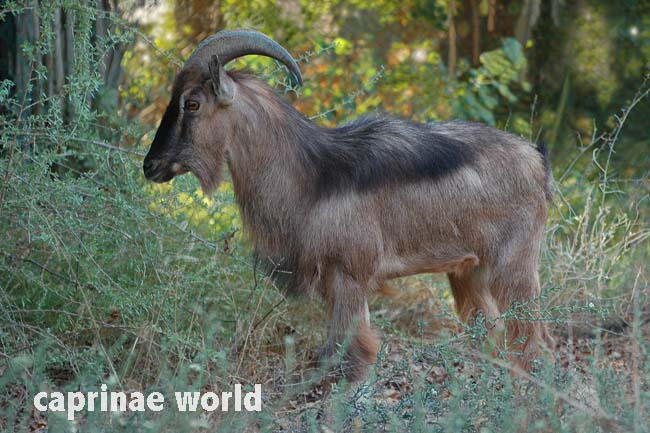
Habitats of Arabian Tahr are generally barren. Presumably this is due to displacement through livestock. Habitats with a diverse vegetation are also taken if available. Photo: Breeding Centre for Endangered Arabian Wildlife
Food and feeding
Arabian Tahrs are (probably [3]) primarily browsers, feeding on leaves, fruits and seeds from a variety of trees and shrubs [1], but also grasses. [3]
Drinking: It has been reported that Arabian Tahr must drink every two to three days during the hot summers when lush vegetation or fruits of the But tree (Sideroxylon mascatense) are not available. Although their water dependency is likely, the frequency of drinking remains unverified. When water sources dry and vegetation depletes, they reportedly move to new areas. [1] There is widespread anecdotal evidence of tahrs drinking at night from the sources of the ‘falaj’ channel irrigation systems. In times of severe drought tahrs have been found in poor condition in a number of areas of its range, some of which have died. [2]
Breeding
breeding season: September to November [1, 3] A second rut, known as ‘Lia’ah adh dhubab’, is reported to occur in February in years when there is good forage after early rainfall (Wood 1992; Insall 1999). [1, 2]
breeding season activity: Males are known to move long distances between known populations to find females. [2]
gestation: ca. 150 days [3], 140 [1]
lambing season: March-April; births in captivity occur throughout the year [3], in case the young dies, females apparently enter into estrus again. In captivity a second reproduction is known to occur. [1]
young per birth: one; twinning is rear [3], has never been recorded [1]
Activity patterns
Accounts are contradicting: It is stated that Arabian Tahr are „diurnal, grazing in the early morning and late afternoon“ [2], „probably also nocturnal, depending on the season and temperature“ [3] and „primarily crepuscular“ [1].
Movements, home range and social organisation
Older reports claim that Arabian Tahr are territorial, but recent evidence, although not conclusive, suggests they do not hold exclusive territories. Nevertheless Arabian Tahr appear to mark small areas by scraping their horns in the soil, and the depressions may contain hair, faeces and urine. [1]
They probably have daily elevational movements, but detailed studies are lacking. Long-range movements probably occur to find areas with green forage resulting from localized rainfall. Arabian Tahr usually live in small groups composed of two adults or two adults and young, but solitary animals are common. Largest groups consisted of 4 to 11 animals. They do not form spatially segregated all male or female groups, but this could be a consequence of the low population numbers. [3]
Status, threats and conservation
IUCN Red List Category (2008): „Endangered“ [2]
Total population estimates range from less than 2.000 to less than 5.000. But most populations are unmonitored, their status and numbers are unknown. [3] Arabian Tahr occur in small, scattered populations that are vulnerable to extirpation. [3] Although some populations may have increased through protection, overall it is likely that the species continues to decline. [2] The February 2000 Workshop of Population and Habitat Viability Assessment (PHVA) for the Arabian Leopard and Tahr predicted, however, that the Arabian Tahr population should exceed 6.000 individuals. [1]
The greatest threat to the survival of the species is loss of habitat (Insall 1999). Although within guarded areas its status is sound, elsewhere problems include restricted available habitat, and most importantly, competition with livestock, primarily domestic goats. In some areas of prime habitat there has been a steady increase in domestic livestock numbers, where new road networks make it easy to transport animals to new pasture or to bring in supplementary food and water.
Areas with increasing livestock include the high plateaus of the Eastern Hajar Range, the Jabal Al Akhdhar and Jabal Kawr in the Western Hajar.
In most other areas of the tahr’s range there is strong anecdotal evidence that domestic livestock numbers have decreased. However, active shepherding of livestock has all but ceased, increasing the occurrence of stray animals, which become feral and then breed in areas of tahr habitat. [2]
Diseases: There is evidence that Arabian Tahrs are susceptible to diseases that affect domestic goats. This will remain an ongoing threat until vaccination of domestic animals against clostridial diseases becomes compulsory. [2]
Cases of warble fly strike occurred in the Tanuf area of the south-facing cliffs of the Jabal Al Akhdhar in early 2000. [2]
Illegal hunting remains a significant threat in some areas. [2] Tahr meat is considered a delicacy, and rural community members are not always aware of the endagered status of the animal. [1] It has been illegal to kill or capture tahr in Oman since the Royal Decree issued in 1976 (Ministry of Diwan Affairs, Ministerial Decision No. 4), but the terrain and distribution make this difficult to enforce. Poaching is still exacerbated by the burgeoning network of graded secondary roads, which are fragmenting the tahr’s habitat throughout its range. [2]
Illegal catpure and clandestine trade to countries outside Oman (with a very high mortality rate) is also reported as a serious threat over the last 10 years (Spalton 2012, pers. comm.) [1]
A prospective increase in mineral mining, especially in the ophiolite mountains, threatens to degrade both vegetation and groundwater supplies upon which the tahr depends. [2]
Captive breeding centres have been established in Oman and the United Arab Emirates. At the Omani Captive Breeding Centre for Mammals at Bait al Barakah, Northern Oman Arabian Tahr have been reproduced. The species has proved difficult to rear in captivity when compared with other native ruminants, so none have yet (2008) been released into the wild. It is intended that surplus animals will be used for reintroductions and for supplementing existing populations. [2] In the United Arab Emirates, Sharjah, the Breeding Centre for Endangered Arabian Wildlife opened in 1998. [7]
Wildlife guards in Oman: Following two years of field study from 1973, a special wildlife guard force (“mushrafin”), administered by the Diwan of the Royal Court, was established in 1975 to protect Arabian Tahr. The mushrafin operate in the following locations [2]:
in a 200 km² area in the mountainous region of the Jabal Aswad escarpment 45 km south of Muscat, encompassing the watershed of the Wadi As Sareen, a number of tahr guards were appointed from local tribes originally to patrol just the Wadi As Sareen Nature Reserve, but subsequently their jurisdiction was extended to include Jabal Sa’atari 20 km to the north. The area patrolled by the guards was further extended, and by 1992 they protected tahr and Arabian gazelle in an area of about 2.350 km², including the mountains near Nakhl 70 km south-west of Muscat and the Jabal Bani Jabir about 120 km south-east of Muscat. In addition, a number of villagers are retained to report any poaching attempts.
Additional agreements with livestock owners: All the patrolled areas contain good quality habitat, but tahr populations are small and isolated, and thus vulnerable to diseases introduced by domestic stock, and other stochastic events. In 1979 an agreement was made with three local families to keep their domestic livestock out of a 16 km² area of the Jabal Aswad cliff overlooking Wadi Qiyd, an area of particular importance for the tahr.
Wildlife rangers: In 1993 the Ministry of Regional Municipalities and Environment (now Ministry of Environment and Climate Affairs) established a small wildlife ranger unit in the Ja’alan to guard a population of Arabian gazelle at As Saleel, near Al Kamil. The following year this was expanded to look after a substantial tahr population in Jabal Qahwan. Further units were established elsewhere in Oman, those in the north specifically tasked with identifying and monitoring further tahr populations. They now operate in all areas of the tahr’s range.
Improved tahr protection: The personal interest of the Omani ruler, His Majesty Sultan Qaboos bin Said, has enhanced tahr protection, with the implementation of a new tahr management plan. A new project is underway to update the 1995 Strategy and Action Plan for the Conservation of the species. More ranger units are being recruited and trained to operate in the tahr’s range. [1]
There are three protected areas in Oman and UAE, of which Wadi al Sareen nature reserve in Oman (in the Easern Hajar Mountains, about 45 km southwest of Muscat) contains one of the largest and most important Arabian Tahr habitats. [1]
Trophy hunting
Not a factor today. British military officer, explorer and writer Wilfred Thesiger hunted at Jebel Hafit, UAE, in May 1949. He claims to have been the first European to have seen an Arabian Tahr – in 1949! In his book Arabian Sands (page 274) he writes:
„While I had been at Muwaiqih [today’s Al Ain] I had hunted tahr on Jabal Hafit, camping for a week under the mountain with bin Kabina and bin Ghabaisha and two Zayid’s Arab. The Arabian Tahr had never previously been seen by a European, although they had been named from two skins bought in Muscat by Dr. Jayakar in 1892. [ … ] It was exhausting work hunting them, for the mountains rose four thousand feet above our camp, and the slopes were everywhere steep and usually sheer, without water or vegetation. The tahr fed at night round the foot of the mountain, but the only ones we saw were near the top. The Arabs shot two females and we picked up the skull of a male. We had made ourselves sandals from green hide [otherwise Thesiger and his men travelled barefoot! through the desert.] without which we could never have climbed these cruel limestone rocks.“
Ecotourism
Arabian Tahrs have been just detected by wildlife watchers. As of 2022 only a few trip reports related to this species are available on mammalwatching.com. The vicinity of the Mercure Hotel at Jebel Hafeet, UAE, seems to be a more or less reliable place to see the species.
In 2016 the „Al Hefaiyah Mountain Conservation Center“ near Kalba (Sharjah emirate) opened for visitors. The 12 km² wildlife conservation centre is located at the base of the Hajar Mountains. The tahr is on display. [6]
Literature Cited
[1] Damm, Gerhard R. and Franco, Nicolás, 2014: The CIC Caprinae Atlas of the World – CIC International Coucil for Game and Wildlife Conservation, Budakeszi, Hungary in cooperation with Rowland Ward Publications RSA (Pty) Ltd., Johannesburg, South Africa.
[2] Insall, D. 2008. Arabitragus jayakari. The IUCN Red List of Threatened Species 2008: e.T9918A13027045. http://dx.doi.org/10.2305/IUCN.UK.2008.RLTS.T9918A13027045.en. Downloaded on 18 May 2018.
[3] Wilson, D.E. and Mittermeier, R.A. [eds], 2011: Handbook of the Mammals of the World. Vol. 2. Hoofed Mammals. Lynx Edicions, Barcelona.
[4] Groves, Colin and Grubb, Peter, 2011: Ungulate Taxonomy. The John Hopkins University Press.
[5] Castelló, José R., 2016: Bovids of the World – Antelopes, Gazelles, Cattle, Goats, Sheep, and Relatives. Princton University Press.
[6] http://www.sharjahupdate.com/2016/03/sharjahs-new-wildlife-centre-opens-to-tourists/
[7] Homepage of the Breeding Centre for Endangered Arabian Wildlife: www.bceaw.ae
[8] Thesiger, Wilfred, 1959: Arabian Sands. Penguin Books.

